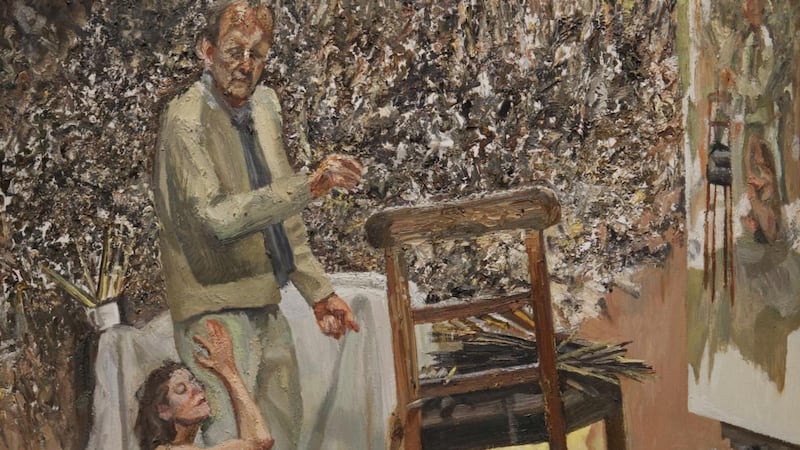
William Feaver begins his intricate, densely textured biography with a remark made to him by the critic David Sylvester in 1995. Lucian Freud wasn’t, Sylvester said, “a born painter . . . [he] had applied himself to the art of painting”, later elaborating his point in an article in the Guardian. When he read it, Feaver reports, Freud laughed. Like most critics and curators early on, including John Berger, Sylvester did not really get Freud and rushed to erroneous judgment, but he had a point. As a painter Freud lacked natural facility and an instinct for or interest in composition. The former he learned to transcend, brilliantly; he remained indifferent about the latter.
The first of two projected volumes, Youth charts Freud’s life up to the late 1960s, just prior to his eventual fame. Born in Berlin in 1922, a grandson of Sigmund Freud, he had a privileged childhood (his father was an architect). In 1934, as the Nazis tightened their grip, his parents moved to London. At boarding school, Freud had a rebellious, subversive attitude. He was much happier at Cedric Morris’s East Anglian art school. His efforts were often presumed to be naive or faux naif, but weren’t actually either. His meticulous depiction of any given subject produced images of obsessive precision that could verge on the surreal. Yet he was aiming for guileless veracity. “I was trying for accuracy of a sort. I didn’t think of detail; it was simply, through my concentration, a question of focus.” He never lost that quality of sustained, relentless focus.
Taken from numerous interviews with Feaver, in person or by phone over a period of many years, Freud’s voice is a startling, almost uncanny constant through the book, a ghostly commentary. His evident honesty is impressive, even if his recall is inevitably subjective (including such minor lapses as mixing the Abbey up with the Gate). Long-term lovers and friends provide essential balance. Even not so long-term. Joan Wyndham, who spent several weeks with him at the beginning of 1946, later wrote: “’One thing I liked about Lucian was that he always told me the truth, no matter how painful. And . . . you never knew where you were with him, and he liked it that way.’” In bed with him one morning she was woken by a girl’s voice saying “Cuppa tea, love?” She opened her eyes to see by Freud’s side a dark-haired girl with huge eyes, who “totally ignored me and didn’t offer me any tea”. Wyndham reported Freud saying that what he really liked was to pick up girls in the park “and bring them home like stray kittens”.
Scandalous anecdotes
Home, that is, to his flat in Delamare Terrace, “on the seamy side of Maida Vale”. Freud was barely into his 20s when he set up home there having lost his previous lodgings and always keen to put distance between himself and his mother. Delamare exemplified his desire to have a foot in diametrically opposite social camps. As “Lu the painter”, he nurtured his relationship with a neighbour, young Charlie Lumley, who became a sidekick and model for several superb paintings. They remained close until Lumley married in 1960. Freud liked to think of himself as streetwise, a bit of an outlaw – as Lumley was in reality – while being simultaneously a dedicated social climber, enraptured with titles, wealth, prestige and gossip. The great and the good, including Brendan Behan and Jack B Yeats, encountered in Dublin, drift continually through these pages, as often as not in scandalous insider anecdotes.

A beneficiary of the royalties on his grandfather’s writings, which grew over the years, but otherwise essentially dependent on selling his work, he was usually short of money but hated the idea of taking money seriously. Like his sometime friend Francis Bacon, he grew into a serious gambling habit, laying large sums, preferably on horses, and occasionally winning. The point, he said, was the all-or-nothing risk: a massive win, or lacking even the bus fare home.
He fell madly in love, serially. The problem was that when he won the object of his affections he didn’t seem to know what to do and sought distraction. Still married to Kitty Epstein, he pursued Caroline Blackwood obsessively, in the face of her family’s ferocious disapproval. Once they eloped and married, he set up a house in the country as though designing a theatrical production, apparently with the best intentions but with a complete absence of conviction and self-knowledge; he couldn’t abide being stuck there. Blackwood eventually walked out on him one evening, having cooked him a supper that he pushed thoughtlessly away. He was shattered.
Emotional turbulence
Earlier on, he fell heavily for Lorna Wishart, who was married, usurping her lover Laurie Lee. Enraged and devastated, Lee later wondered how it had never occurred to him that he would inevitably be the victim of the same deceptions and betrayals Lorna had inflicted on others to be with him. When she dismissed Freud – “I thought I’d given you up for Lent but I’ve given you up for good” – it was because he was clearly involved with someone else, more than one someone, in fact, but again he was utterly shaken and disconsolate.
Throughout all this emotional turbulence, it should be emphasised, he worked continually, creating a significant number of the finest figurative paintings of the 20th century. And he was a famously slow worker. He preferred to begin at one point and work from there, the intact image emerging bit by bit as if by magic as he progressed across the canvas. His subjects were those close to him, those he could persuade to pose for impossible lengths of time, each subjected to that unwavering, concentrated focus.
Apart from intimates – a long list – they included his wider circle, such as the truculent Soho habitue Harry Diamond, the subject of several excellent paintings including Interior in Paddington from 1951. Freud relates how, one evening, a drinking companion, Willy Willetts, who had been advised that his book on Chinese art would be a steady earner, said he was thinking of making Diamond the beneficiary of the royalties. Diamond went home. When he reappeared the next evening he told Willetts he’d been thinking about his offer: “Leave me out. I’m damned if I’m going to be the butt for your philanthropy.” Freud’s jaw dropped: ‘The butt for your philanthropy’, it cannot ever have been said by anyone before.” You can see why he liked Diamond’s perversity.












